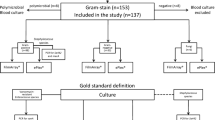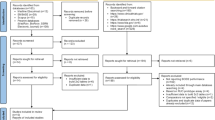Abstract
Among healthcare-associated infections that can affect a critically ill patient, bloodstream infections are one of the most frequent causes of mortality, especially in hospitalized patients. The objective of this work is to evaluate the performance of the XGEN Multi Sepsis Flow Chip for the rapid diagnosis of bloodstream infections compared with conventional tests. In total, 101 positive blood culture samples were included, and the results obtained by the phenotypic conventional method (culture with susceptibility profile) were compared with results obtained by the XGEN Multi Sepsis Flow Chip. This molecular assay allows the simultaneous detection of the main bloodstream infection pathogens, and their most common antibiotic resistance markers in a short period of time. It was possible to observe substantial agreement between the methods for identifying the genus of pathogens. Considering species, the agreement was excellent. In relation to susceptibility, excellent agreement was noted between the detected resistance genes and susceptibility profile obtained through conventional antibiograms. The evaluated assay presented very early and satisfactory results for identification and detection of resistance genes of the main pathogens involved in bloodstream infections.
Similar content being viewed by others
Data Availability
When data are requested, they will be made available.
Code Availability
Not applicable.
References
Vincent JL, Rello J, Marshall J, Silva E, Anzueto A, Martin CD, Moreno R, Lipman J, Gomersall C, Sakr Y, Reinhart K (2009) International study of the prevalence and outcomes of infection in intensive care units. JAMA 302(21):2323–2329. https://doi.org/10.1001/jama.2009.1754
Schwab F, Geffers C, Behnke M, Gastmeier P (2018) ICU mortality following ICU-acquired primary bloodstream infections according to the type of pathogen: a prospective cohort study in 937 Germany ICUs (2006–2015). PLoS ONE 13(3):e0194210. https://doi.org/10.1371/journal.pone.0194210
Maharath A, Ahmed MS (2021) bacterial etiology of bloodstream infections and antimicrobial resistance patterns from a tertiary care hospital in malé. Maldives Int J Microbiol 2021:3088202. https://doi.org/10.1155/2021/3088202
Martins HS, Brandão Neto RA, Scalabrini Neto A, Velasco IT (2012) Emergências clínicas: abordagem prática. Manole São Paulo
Andriolo A (2018) Manual da residência de medicina laboratorial
Vasudeva N, Nirwan PS, Shrivastava P (2016) Bloodstream infections and antimicrobial sensitivity patterns in a tertiary care hospital of India. Ther Adv Infect Dis 3(5):119–127. https://doi.org/10.1177/2049936116666983
Tabah A, Lipman J, Barbier F, Buetti N, TimsitPatients—ESGCIP obotESGfIiCI J-F (2022) Use of Antimicrobials for bloodstream infections in the intensive care unit, a clinically oriented review. Antibiotics 11(3):362
Banerjee R, Teng CB, Cunningham SA, Ihde SM, Steckelberg JM, Moriarty JP, Shah ND, Mandrekar JN, Patel R (2015) Randomized trial of rapid multiplex polymerase chain reaction-based blood culture identification and susceptibility testing. Clin Infect Dis Off Publ Infect Dis Soci Am 61(7):1071–1080. https://doi.org/10.1093/cid/civ447
Bizzini A, Jaton K, Romo D, Bille J, Prod’hom G, Greub G (2011) Matrix-assisted laser desorption ionization-time of flight mass spectrometry as an alternative to 16S rRNA gene sequencing for identification of difficult-to-identify bacterial strains. J Clin Microbiol 49(2):693–696. https://doi.org/10.1128/jcm.01463-10
Beganovic M, Costello M, Wieczorkiewicz SM (2017) Effect of matrix-assisted laser desorption ionization-time of flight mass spectrometry (MALDI-TOF MS) alone versus MALDI-TOF MS combined with real-time antimicrobial stewardship interventions on time to optimal antimicrobial therapy in patients with positive blood cultures. J Clin Microbiol 55(5):1437–1445. https://doi.org/10.1128/jcm.02245-16
Timsit JF, Bassetti M, Cremer O, Daikos G, de Waele J, Kallil A, Kipnis E, Kollef M, Laupland K, Paiva JA, Rodríguez-Baño J, Ruppé É, Salluh J, Taccone FS, Weiss E, Barbier F (2019) Rationalizing antimicrobial therapy in the ICU: a narrative review. Intensive Care Med 45(2):172–189. https://doi.org/10.1007/s00134-019-05520-5
Stefaniuk E, Baraniak A, Gniadkowski M, Hryniewicz W (2003) Evaluation of the BD Phoenix automated identification and susceptibility testing system in clinical microbiology laboratory practice. Eur J Clin Microbiol Infect Dis Off Publ Eur Soci Clin Microbiol 22(8):479–485. https://doi.org/10.1007/s10096-003-0962-y
Becton D (2005) BD Phoenix system user's manual, document L003342(M). In., p 13
Dingle TC, Butler-Wu SM (2013) Maldi-tof mass spectrometry for microorganism identification. Clin Lab Med 33(3):589–609. https://doi.org/10.1016/j.cll.2013.03.001
O’Grady NP, Alexander M, Burns LA, Dellinger EP, Garland J, Heard SO, Lipsett PA, Masur H, Mermel LA, Pearson ML, Raad II, Randolph AG, Rupp ME, Saint S (2011) Guidelines for the prevention of intravascular catheter-related infections. Clin Infect Dis Off Publ Infect Dis Soci Am 52(9):e162-193. https://doi.org/10.1093/cid/cir257
Greene ES (2021) Challenges in reducing the risk of infection when accessing vascular catheters. J Hosp Infect 113:130–144. https://doi.org/10.1016/j.jhin.2021.03.005
Agrawal V, Valson AT, Bakthavatchalam YD, Kakde S, Mohapatra A, David VG, Alexander S, Jacob S, Jude Prakash JA, Veeraraghavan B, Varughese S (2022) Skin Colonizers and Catheter Associated Blood Stream Infections in Incident Indian Dialysis Patients. Indian journal of nephrology 32(1):34–41. https://doi.org/10.4103/ijn.IJN_400_20
Rocchetti TT, Martins KB, Martins PYF, Oliveira RA, Mondelli AL, Fortaleza C, Cunha M (2018) Detection of the mecA gene and identification of Staphylococcus directly from blood culture bottles by multiplex polymerase chain reaction. Brazilian J Infect Dis Off Publ Brazilian Soci Infect Dis 22(2):99–105. https://doi.org/10.1016/j.bjid.2018.02.006
Silveira GP, Nome F, Gesser JC, Sá MM, Terenzi H (2006) Recent achievements to combat bacterial resistance. Química Nova [online] 29(4):844–855. https://doi.org/10.1590/S0100-40422006000400037
Yang S, Rothman RE (2004) PCR-based diagnostics for infectious diseases: uses, limitations, and future applications in acute-care settings. Lancet Infect Dis 4(6):337–348. https://doi.org/10.1016/s1473-3099(04)01044-8
Afshari A, Schrenzel J, Ieven M, Harbarth S (2012) Bench-to-bedside review: Rapid molecular diagnostics for bloodstream infection–a new frontier? Crit Care 16(3):222. https://doi.org/10.1186/cc11202
La Scola B (2011) Intact cell MALDI-TOF mass spectrometry-based approaches for the diagnosis of bloodstream infections. Expert Rev Mol Diagn 11(3):287–298. https://doi.org/10.1586/erm.11.12
Laupland KB, Zygun DA, Davies HD, Church DL, Louie TJ, Doig CJ (2002) Population-based assessment of intensive care unit-acquired bloodstream infections in adults: Incidence, risk factors, and associated mortality rate. Crit Care Med 30(11):2462–2467. https://doi.org/10.1097/00003246-200211000-00010
Zowawi HM, Forde BM, Alfaresi M, Alzarouni A, Farahat Y, Chong TM, Yin WF, Chan KG, Li J, Schembri MA, Beatson SA, Paterson DL (2015) Stepwise evolution of pandrug-resistance in Klebsiella pneumoniae. Sci Rep 5:15082. https://doi.org/10.1038/srep15082
Fedler KA, Biedenbach DJ, Jones RN (2006) Assessment of pathogen frequency and resistance patterns among pediatric patient isolates: report from the 2004 SENTRY antimicrobial Surveillance Program on 3 continents. Diagn Microbiol Infect Dis 56(4):427–436. https://doi.org/10.1016/j.diagmicrobio.2006.07.003
Galiana A, Coy J, Gimeno A, Guzman NM, Rosales F, Merino E, Royo G, Rodríguez JC (2017) Evaluation of the sepsis flow chip assay for the diagnosis of blood infections. PLoS ONE 12(5):e0177627. https://doi.org/10.1371/journal.pone.0177627
Quiles MG, Boettger BC, Inoue FM, Monteiro J, Santos DW, Ponzio V, Carlesse F, Cappellano P, Carvalhaes CG, Pignatari ACC (2019) Direct matrix-assisted laser desorption ionization time-of-flight mass spectrometry and real-time PCR in a combined protocol for diagnosis of bloodstream infections: a turnaround time approach. Brazilian J Infect Dis Off Publ Brazilian Soci Infect Dis 23(3):164–172. https://doi.org/10.1016/j.bjid.2019.05.005
Brasil (2013) Nota técnica nº 01/2013 - Medidas de prevenção e controle de infecções por enterobactérias multirresistentes In: Anvisa Andvs- (ed). Brasília, p 22
Vardakas KZ, Anifantaki FI, Trigkidis KK, Falagas ME (2015) Rapid molecular diagnostic tests in patients with bacteremia: evaluation of their impact on decision making and clinical outcomes. Eur J Clin Microbiol Infect Dis 34(11):2149–2160. https://doi.org/10.1007/s10096-015-2466-y
Mancini N, Carletti S, Ghidoli N, Cichero P, Burioni R, Clementi M (2010) The era of molecular and other non-culture-based methods in diagnosis of sepsis. Clin Microbiol Rev 23(1):235–251. https://doi.org/10.1128/cmr.00043-09
Funding
None.
Author information
Authors and Affiliations
Contributions
MMM and CGC made substantial contributions to the conception, design, analysis of the data, draft of the work, and revision of the work; KB, BCB, ACCP performed acquisition and analysis of the data, and revision of the work. All authors read and approved the final manuscript.
Corresponding author
Ethics declarations
Conflicts of interest
None.
Ethical Approval
This study was approved by the local ethical committee of Hospital São Paulo/UNIFESP (CAAE:77096017.9.0000.5505).
Consent to Participate
All authors agreed to participate.
Consent for Publication
All authors agreed to this submission.
Additional information
Publisher's Note
Springer Nature remains neutral with regard to jurisdictional claims in published maps and institutional affiliations.
Supplementary Information
Below is the link to the electronic supplementary material.
Rights and permissions
Springer Nature or its licensor (e.g. a society or other partner) holds exclusive rights to this article under a publishing agreement with the author(s) or other rightsholder(s); author self-archiving of the accepted manuscript version of this article is solely governed by the terms of such publishing agreement and applicable law.
About this article
Cite this article
Maluf, M.M., Bauab, K., Boettger, B.C. et al. Evaluation of XGEN Multi Sepsis Flow Chip Molecular Assay for Early Diagnosis of Bloodstream Infection. Curr Microbiol 80, 231 (2023). https://doi.org/10.1007/s00284-023-03325-w
Received:
Accepted:
Published:
DOI: https://doi.org/10.1007/s00284-023-03325-w




